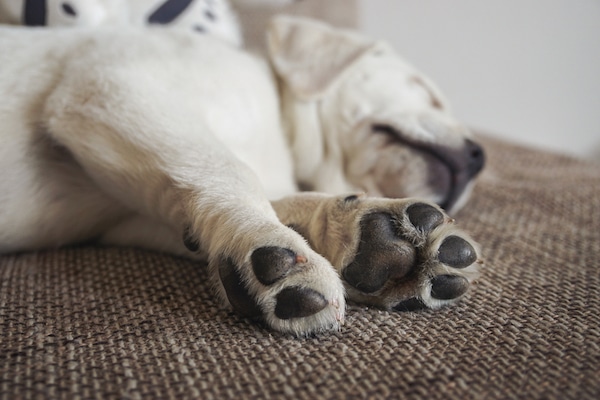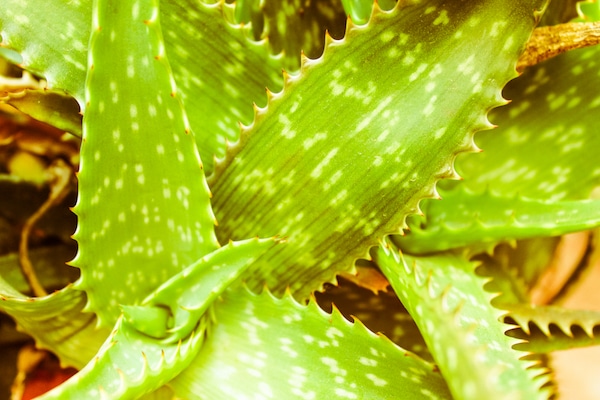In many parts of the country, you know spring is afoot when the weather begins displaying seizure-like shifts from warm, to freezing, to snowy, to stormy — often in the same day or week. What’s important to remember is that our pets require paw pad protection from so many of these factors. In fact, a range of irritants can contribute to paw problems all year long — deep snow, freezing winter roads, commonly used chemicals, scorching summer temps and more.

Sleeping puppy by Shutterstock.
Some people mistakenly conclude that pooch paws must be practically immune to injury; citing the outdoor resilience of wolves, coyotes and sled dogs. It’s true that paw pads are basically anatomical shock-absorbers equipped with thick, durable skin. Ordinarily, they have no trouble withstanding the normal wear-and-tear of walks, jogs and daily playtime. But there are limits. My Bichon, Sparky, for example, sustained some nasty paw pad damage after scrambling down a jagged gravel path in pursuit of a crafty squirrel. Other common paw injury culprits can include the following:
Allergies
According to veterinarian Dr. Karen Becker, underlying food or environmental allergies can often show up as irritation on the paws or in the ears. Sometimes, pets can even track in common allergens like pollen and then ingest these allergens as they lick their paws.
Environmental factors
Many of the situations mentioned above are common culprits. In particular, road salt and other ice-melting chemicals can often do a number on the skin beneath paws and between toes. But herbicides, fertilizers and pesticides can also play a huge role — and again, paw-licking may only compound the problem.
Yeast infections
In his Complete Guide to Natural Health for Dogs & Cats, Dr. Richard Pitcairn notes that dogs with chronically itchy, irritated skin — especially those with that characteristic “corn chip” aroma — are often struggling with an internal overbalance of yeast. Sometimes, he explains, the first sign of that irritation shows up on the paw pads.
Holistic veterinarian Dr. Donna M. Starita has also noted that, while contact with rough surfaces or environmental irritants may aggravate your pup’s paws, the problem could be systemic. This is why standard veterinary treatments — which often include topical ointments, corticosteroids and non-steroidal anti-inflammatory drugs (NSAIDS) — may fail to address the real root of the issue. Prolonged use of these treatments also come with potentially serious side effects, including organ damage.
So if your dog’s irritated paws don’t ever seem to be clearing up, talk with your vet. But to help relieve and prevent more temporary/situational problems, consider these four natural ways to soothe, pamper, cleanse and heal your pet’s paws at home.
1. Provide natural barriers
I’ve found that a very thin layer of food-grade wax — such as beeswax, or those contained in the excellent and highly emollient Musher’s Secret — can help protect sensitive paws against the elements all year long. You can rub these waxes in before going outside to help discourage chapping and irritation. They’re technically edible, but just don’t overdo it.
2. Consider healing minerals
In the book New Choices in Natural Healing for Dogs & Cats, Dr. Starita mentions that dietary deficiencies involving selenium and zinc can often lead to cracked pads. Selenium boosts general immunity, and zinc can strengthen the skin itself so it heals more rapidly. She suggests giving pets under 30 pounds 2.5 to 5 milligrams of zinc, plus up to 50 micrograms of selenium per day. Larger pets can typically tolerate 5 to 10 milligrams of zinc, plus up to 100 micrograms of selenium per day. After consulting your vet, try two weeks on, two weeks off, and decrease the dosage if minor stomach upset occurs.
3. Try oil and aloe vera

Aloe vera by Shutterstock.
Paw pads need to be tough to maintain their protective qualities, so you don’t want to over-soften them. However, if you notice actual cracks, I’ve found that applying a bit of olive oil, coconut oil or sesame oil can help speed healing. In moderation, these options are all safely ingested if your pet attempts to lick them off. I also sometimes use a tiny bit of natural Vitamin E oil or natural aloe vera gel. However, with this approach it’s best to keep your pup preoccupied for several minutes as the application soaks in.
4. Wash it off
Perhaps the simplest and most effective way to remove irritants from your dog’s or cat’s paws is by simply rinsing them away. Some pet parents do this with a damp cloth, but keep in mind that rubbing can further aggravate areas that are already tender. This is why a brief five-second dunk — or even a longer, 20-second paw soak — can have healing benefits, so long as you remember to gently pat the paws dry. Depending upon the size of your pet, you can use a bowl, basin, bathtub or even a small kiddie pool for this purpose.
There are a number of paw wash mixtures you may want to try. One ultra-luxurious option is Deep Cleaning Paw Fizz Tablets by Warren London. But you can easily make a soothing paw soak solution at home, from ingredients you probably have in your pantry right now. Consider some of these natural options, which I’ve used with numerous dogs over the years:
Water + Iodine — As a naturally occurring, water-soluble element, iodine is a mild disinfectant with both anti-fugal and anti-viral properties. When it’s used as part of a very weak topical solution, it’s also safe for most pets. I never add more than 1 tablespoon for every 3 cups of warm water, then swish each paw for a few seconds and pat dry.
Water + Apple Cider Vinegar — Organic, unfiltered, unpasteurized apple cider vinegar contains acetic acid and malic acid that give it anti-bacterial, anti-fungal and anti-viral properties. Just make sure you’re not using the plastic bottle varieties found in grocery store aisles. Those products have been treated so that most of the natural medicinal qualities are removed. I normally add up to 2 tablespoons for every three cups of warm water, and then pour this solution into a spray bottle and lightly mist each paw. Just remember that apple cider vinegar can sting existing cuts, so dilute further if that seems to be happening.
Water + Peppermint Essential Oil — The menthol properties of peppermint are cooling to paw irritations, and the sharp aroma often discourages licking. To take advantage of peppermint’s soothing, natural antiseptic properties, I routinely add about 5 drops of peppermint essential oil to 3 cups of warm water. Then, I soak each individual paw for about 30 seconds, and then dry thoroughly with a clean, fluffy towel. You can also use a blow dryer on the absolute lowest heat setting, held at least 6 inches away from each paw.
What have you tried to help soothe and protect your pet’s paws at home? Share your insights here!
The post 4 Natural Ways to Protect Your Dog’s Paws Year-Round appeared first on Dogster.
No comments:
Post a Comment